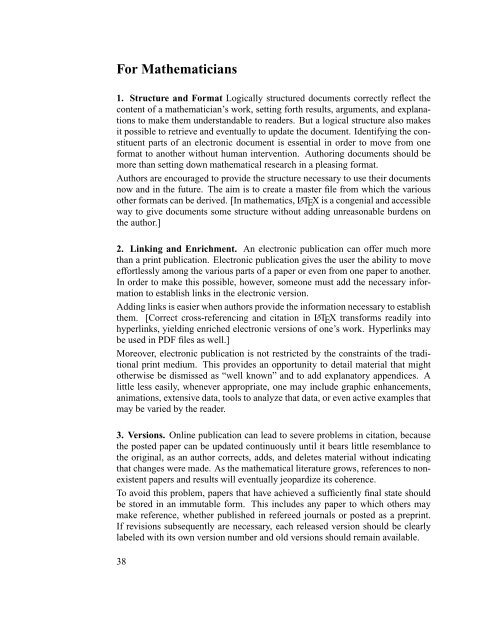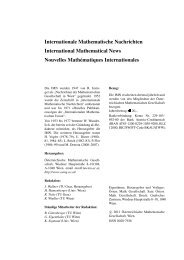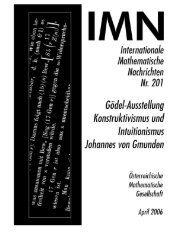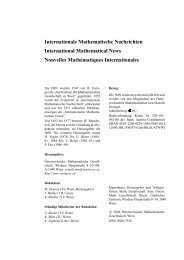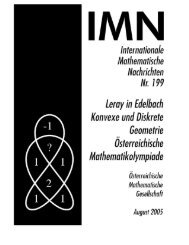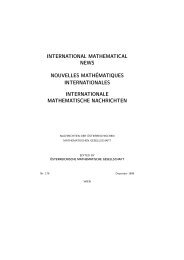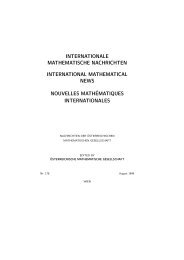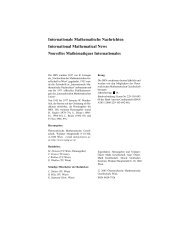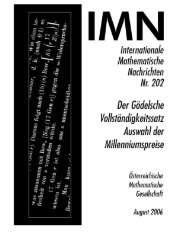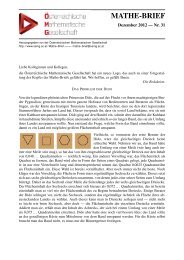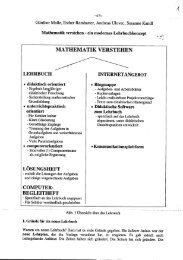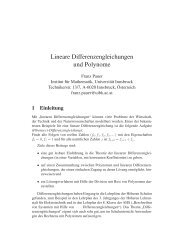190 - Ãsterreichische Mathematische Gesellschaft
190 - Ãsterreichische Mathematische Gesellschaft
190 - Ãsterreichische Mathematische Gesellschaft
Sie wollen auch ein ePaper? Erhöhen Sie die Reichweite Ihrer Titel.
YUMPU macht aus Druck-PDFs automatisch weboptimierte ePaper, die Google liebt.
For Mathematicians<br />
1. Structure and Format Logically structured documents correctly reflect the<br />
content of a mathematician’s work, setting forth results, arguments, and explanations<br />
to make them understandable to readers. But a logical structure also makes<br />
it possible to retrieve and eventually to update the document. Identifying the constituent<br />
parts of an electronic document is essential in order to move from one<br />
format to another without human intervention. Authoring documents should be<br />
more than setting down mathematical research in a pleasing format.<br />
Authors are encouraged to provide the structure necessary to use their documents<br />
now and in the future. The aim is to create a master file from which the various<br />
other formats can be derived. [In mathematics, LATEX is a congenial and accessible<br />
way to give documents some structure without adding unreasonable burdens on<br />
the author.]<br />
2. Linking and Enrichment. An electronic publication can offer much more<br />
than a print publication. Electronic publication gives the user the ability to move<br />
effortlessly among the various parts of a paper or even from one paper to another.<br />
In order to make this possible, however, someone must add the necessary information<br />
to establish links in the electronic version.<br />
Adding links is easier when authors provide the information necessary to establish<br />
them. [Correct cross-referencing and citation in LATEX transforms readily into<br />
hyperlinks, yielding enriched electronic versions of one’s work. Hyperlinks may<br />
be used in PDF files as well.]<br />
Moreover, electronic publication is not restricted by the constraints of the traditional<br />
print medium. This provides an opportunity to detail material that might<br />
otherwise be dismissed as “well known” and to add explanatory appendices. A<br />
little less easily, whenever appropriate, one may include graphic enhancements,<br />
animations, extensive data, tools to analyze that data, or even active examples that<br />
may be varied by the reader.<br />
3. Versions. Online publication can lead to severe problems in citation, because<br />
the posted paper can be updated continuously until it bears little resemblance to<br />
the original, as an author corrects, adds, and deletes material without indicating<br />
that changes were made. As the mathematical literature grows, references to nonexistent<br />
papers and results will eventually jeopardize its coherence.<br />
To avoid this problem, papers that have achieved a sufficiently final state should<br />
be stored in an immutable form. This includes any paper to which others may<br />
make reference, whether published in refereed journals or posted as a preprint.<br />
If revisions subsequently are necessary, each released version should be clearly<br />
labeled with its own version number and old versions should remain available.<br />
38


